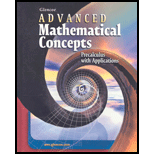
Concept explainers
a.
To calculate: The number of different ways to arrange cars.
a.
Answer to Problem 48E
The number of different ways to arrange cars are
Explanation of Solution
Given information:
There are 12 flatcars, 10 tanker cars, 15 boxcars and 5 livestock cars.
Formula used:
If there are n objects taken n at a time then permutation is defined as
Calculation:
Consider the provided information that there are 12 flatcars, 10 tanker cars, 15 boxcars and 5 livestock cars.
Total number of cars are,
In order to arrange these 42 cars, use permutation as selection matters.
Recall that if there are n objects taken n at a time then permutation is defined as
Here n is 42.
Required number of ways are
Thus, the number of different ways to arrange cars are
b.
To calculate: The number of different ways to arrange 30 cars to make the train.
b.
Answer to Problem 48E
The number of different ways to arrange 30 cars to make the trainare
Explanation of Solution
Given information:
There are 12 flatcars, 10 tanker cars, 15 boxcars and 5 livestock cars.
Formula used:
If there are n objects taken r at a time then combination is defined as
Calculation:
Consider the provided information that there are 12 flatcars, 10 tanker cars, 15 boxcars and 5 livestock cars.
Total number of cars are,
In order to arrange these 30 cars, use combination as selection does not matter.
Required number of ways are
Recall that if there are n objects taken r at a time then combination is defined as
Here n is 42 and r is 30.
Thus, the number of different ways to arrange 30 cars to make the train are
c.
To calculate: The number of different ways to form a train with 3 livestock cars, 6 flatcars, 6 tanker cars and 5 boxcars.
c.
Answer to Problem 48E
The number of different ways to form a train with 3 livestock cars, 6 flatcars, 6 tanker cars and 5 boxcarsare
Explanation of Solution
Given information:
There are 12 flatcars, 10 tanker cars, 15 boxcars and 5 livestock cars.
Formula used:
If there are n objects taken r at a time then combination is defined as
Calculation:
Consider the provided information that there are 12 flatcars, 10 tanker cars, 15 boxcars and 5 livestock cars.
Total number of cars are,
In order to form a train with 3 livestock cars, 6 flatcars, 6 tanker cars and 5 boxcars, use combination as selection does not matter.
Out of 5, 3 livestock cars are to be selected.
Out of 12, 6 flat cars are to be selected.
Out of 10, 6 tanker cars are to be selected.
Out of 15, 5boxcars are to be selected.
Required number of ways are
Recall that if there are n objects taken r at a time then combination is defined as
Thus, the number of different ways to form a train with 3 livestock cars, 6 flatcars, 6 tanker cars and 5 boxcars are
Chapter 13 Solutions
Advanced Mathematical Concepts: Precalculus with Applications, Student Edition
Additional Math Textbook Solutions
Calculus: Early Transcendentals (3rd Edition)
Thomas' Calculus: Early Transcendentals (14th Edition)
University Calculus: Early Transcendentals (4th Edition)
University Calculus: Early Transcendentals (3rd Edition)
Single Variable Calculus: Early Transcendentals (2nd Edition) - Standalone book
 Calculus: Early TranscendentalsCalculusISBN:9781285741550Author:James StewartPublisher:Cengage Learning
Calculus: Early TranscendentalsCalculusISBN:9781285741550Author:James StewartPublisher:Cengage Learning Thomas' Calculus (14th Edition)CalculusISBN:9780134438986Author:Joel R. Hass, Christopher E. Heil, Maurice D. WeirPublisher:PEARSON
Thomas' Calculus (14th Edition)CalculusISBN:9780134438986Author:Joel R. Hass, Christopher E. Heil, Maurice D. WeirPublisher:PEARSON Calculus: Early Transcendentals (3rd Edition)CalculusISBN:9780134763644Author:William L. Briggs, Lyle Cochran, Bernard Gillett, Eric SchulzPublisher:PEARSON
Calculus: Early Transcendentals (3rd Edition)CalculusISBN:9780134763644Author:William L. Briggs, Lyle Cochran, Bernard Gillett, Eric SchulzPublisher:PEARSON Calculus: Early TranscendentalsCalculusISBN:9781319050740Author:Jon Rogawski, Colin Adams, Robert FranzosaPublisher:W. H. Freeman
Calculus: Early TranscendentalsCalculusISBN:9781319050740Author:Jon Rogawski, Colin Adams, Robert FranzosaPublisher:W. H. Freeman
 Calculus: Early Transcendental FunctionsCalculusISBN:9781337552516Author:Ron Larson, Bruce H. EdwardsPublisher:Cengage Learning
Calculus: Early Transcendental FunctionsCalculusISBN:9781337552516Author:Ron Larson, Bruce H. EdwardsPublisher:Cengage Learning





